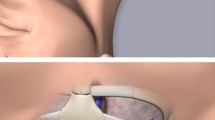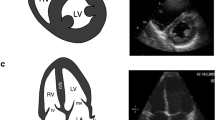Abstract
Background
Surgical trainees performing subclavian vein (SCV) cannulation often incorrectly perceive needle trajectory and anatomical relations. As surface landmark-based methods derived from adult surgical practice may be less effective in younger patients, we developed and evaluated a novel bony landmark-based method for teaching SCV cannulation for central venous access device (CVAD) placement in children.
Methods
Over 2 sequential 3-year periods, pediatric surgical trainees were taught infraclavicular SCV cannulation via surface- and bony-landmark approaches, respectively. We prospectively recorded patient, surgeon and operative details on all Hickman line and port-a-cath insertions placed by trainees as the first surgeon via percutaneous infraclavicular SCV puncture and compared procedural outcomes and complications across both periods.
Results
Of 271 cases included in the study, trainees performed 52 (50.5%) and 92 (54.8%) procedures in the first and second periods, respectively. Patients in both periods did not differ by gender, disease, CVAD device, or prior CVAD, chemotherapy or infection status. In the second (bony landmark) period, although patients were younger (6.0 vs. 8.7 years, P = 0.003) mean procedural duration was shorter (42.5 vs. 58.3 min, P < 0.001). Also, cannulation attempts and complication rates did not differ significantly between study periods (P = 0.257 and 1.0, respectively).
Conclusions
With the bony landmark approach, trainees could perform the procedures faster despite operating on younger patients, without impacting complication rates and cannulation attempts. Bony landmarks may better approximate SCV position across a range of ages, thus improving the consistency of SCV cannulation in CVAD placements in children.


Similar content being viewed by others
References
Bruzoni M, Slater BJ, Wall J, Peter SDS, Dutta S (2013) A prospective randomized trial of ultrasound- vs landmark-guided central venous access in the pediatric population. J Am Coll Surg 216(5):939
Byon HJ, Lee GW, Lee JH, Park YH, Kim HS, Kim CS et al (2013) Comparison between ultrasound-guided supraclavicular and infraclavicular approaches for subclavian venous catheterization in children—a randomized trial. Br J Anaesth 111(5):788–792
Tan B-K, Wong C-H, Ng R, Huang MHS, Lee S-T (2005) A modified technique of percutaneous subclavian venous catheterization in the oedematous burned patient. Burns 31(4):505–509
Parienti J-J, Mongardon N, Mégarbane B, Mira J-P, Kalfon P, Gros A et al (2015) Intravascular complications of central venous catheterization by insertion site. N Engl J Med 373(13):1220–1229
Pirotte T, Veyckemans F (2007) Ultrasound-guided subclavian vein cannulation in infants and children: a novel approach. Br J Anaesth 98(4):509–514
Park SI, Kim YH, So SY, Kim MJ, Kim HJ, Kim JK (2013) Ultrasound-guided subclavian catheterization in pediatric patients with a linear probe: a case series. Korean J Anesthesiol 64(6):541–544
Tan B-K, Hong S-W, Huang MHS, Lee S-T (2000) Anatomic basis of safe percutaneous subclavian venous catheterization. J Trauma Acute Care Surg 48(1):82
Martynov I, Raedecke J, Klima-Frysch J, Kluwe W, Schoenberger J (2018) Outcome of landmark-guided percutaneously inserted tunneled central venous catheters in infants and children under 3 years with cancer. Pediatr Blood Cancer 65:e27295
Boon JM, Van Schoor AN, Abrahams PH, Meiring JH, Welch T, Shanahan D (2007) Central venous catheterization—an anatomical review of a clinical skill—part 1: subclavian vein via the infraclavicular approach. Clin Anat 20(6):602–611
Aminnejad R, Razavi SS, Mohajerani SA, Mahdavi SA (2015) Subclavian vein cannulation success rate in neonates and children. Anesthesiol Pain Med 5(3):e24156
McGee DC, Gould MK (2003) Preventing complications of central venous catheterization. N Engl J Med 348(12):1123–1133
Araujo CC, Lima MC, Falbo GH (2007) Punção percutênea da veia subclávia em crianças e adolescentes: sucesso, complicações e fatores associados. Jornal de Pediatria 83:64–70
de Jonge RCJ, Polderman KH, Gemke RJBJ (2005) Central venous catheter use in the pediatric patient: mechanical and infectious complications. Pediatr Crit Care Med 6(3):329–339
Lefrant J-Y, Muller L, De La Coussaye J-E, Prudhomme M, Ripart J, Gouzes C et al (2002) Risk factors of failure and immediate complication of subclavian vein catheterization in critically ill patients. Intensive Care Med 28(8):1036–1041
Casado-Flores J, Valdivielso-Serna A, Pérez-Jurado L, Pozo-Román J, Monleón-Luque M, García-Pérez J et al (1991) Subclavian vein catheterization in critically ill children: analysis of 322 cannulations. Intensive Care Med 17(6):350–354
Kilbourne MJ, Bochicchio GV, Scalea T, Xiao Y (2009) Avoiding common technical errors in subclavian central venous catheter placement. J Am Coll Surg 208(1):104–109
Von Goedecke A, Keller C, Moriggl B, Wenzel V, Bale R, Deibl M et al (2005) An anatomic landmark to simplify subclavian vein cannulation: the “deltoid tuberosity”. Anesth Analg 100(3):623–628
Thompson E, Calver L (2005) Safe subclavian vein cannulation. Am Surg 71(2):180–183
Procter A, Lee L (2005) A radiological examination of the subclavian vein in vivo. Can J Anesth 52(1):A159
Mitchell SE, Clark RA (1979) Complications of central venous catheterization. Am J Roentgenol 133(3):467
Kang M, Ryu HG, Son IS, Bahk JH (2011) Influence of shoulder position on central venous catheter tip location during infraclavicular subclavian approach. Br J Anaesth 106(3):344–347
Kitagawa N, Oda M, Totoki T, Miyazaki N, Nagasawa I, Nakazono T et al (2004) Proper shoulder position for subclavian venipuncture: a prospective randomized clinical trial and anatomical perspectives using multislice computed tomography. Anesthesiology 101(6):1306–1312
Kim HJ, Jung SH, Min J, Hong DM, Jeon Y, Bahk JH (2013) Comparison of the neutral and retracted shoulder positions for infraclavicular subclavian venous catheterization: a randomized, non-inferiority trial. Br J Anaesth 111(2):191–196
Fukutome T, Shigematsu A (1986) Prediction of subclavian vein location using plain chest radiography. Resusc 14(4):237–243
Sandhu NS (2004) transpectoral ultrasound-guided catheterization of the axillary vein: an alternative to standard catheterization of the subclavian vein. Anesth Analg 99(1):182–187
Bannon MP, Heller SF, Rivera M (2011) Anatomic considerations for central venous cannulation. Risk Manag Healthcare Policy 4:27–39
Butler KL (2003) Effect of patient position on size and location of the subclavian vein for percutaneous puncture—invited critique. Arch Surg 138(9):1001
LaBan MM, Zierenberg AT, Yadavalli S, Zaidan S (2011) Clavicle-induced narrowing of the thoracic outlet during shoulder abduction as imaged by computed tomographic angiography and enhanced by three-dimensional reformation. Am J Phys Med Rehabilit 90(7):572–578
Lukish J, Valladares E, Rodriguez C, Patel K, Bulas D, Newman KD, Eichelberger MR (2002) Classical positioning decreases subclavian vein cross-sectional area in children. J Trauma 53(2):272–275
Acknowledgements
We thank Dr Evan Lim, DVM, MSc (Medical Art); Ms. Germaine Liew and Ms. Jillian Teo, Singapore Childhood Cancer Registry; Ms. Tan Sheng Hui, VIVA-KKH Paediatric Brain and Solid Tumor Program; Ms. Candy Choo, Department of Paediatric Surgery, KK Hospital.
Funding
This work was supported by the VIVA Foundation for Children with Cancer (AHP Loh), and Children’s Cancer Foundation.
Author information
Authors and Affiliations
Corresponding author
Additional information
Publisher's Note
Springer Nature remains neutral with regard to jurisdictional claims in published maps and institutional affiliations.
Rights and permissions
About this article
Cite this article
Lin, Z.J., Lee, Y.T., Chua, J.H.Y. et al. Evaluation of a Novel Bony Landmark-Based Method for Teaching Percutaneous Insertion of Subclavian Venous Catheters in Pediatric Patients. World J Surg 43, 2106–2113 (2019). https://doi.org/10.1007/s00268-019-04997-x
Published:
Issue Date:
DOI: https://doi.org/10.1007/s00268-019-04997-x




